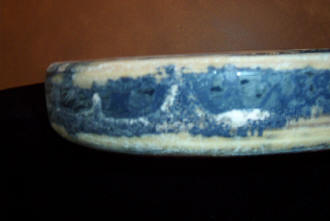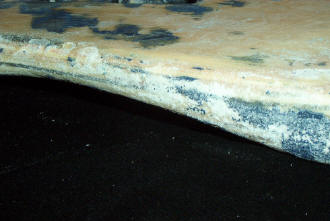 |
STRIPPING A FENDER BULLET BODY |
 |
STRIPPING A FENDER BULLET BODY |
|
Special Thanks to Dave Slusser for providing this article. What does it take to strip the finish from one of those Far-East Strat knockoffs? You know the ones we are talking about -- Fender Bullet, Rogue, etc... Well, our friend Dave Slusser decided to find out, and has the photos to prove it. Some may tell you the best way to paint one of these guitars is to "scuff and spray"; that is, don't strip the body, but rather just scuff the paint already on there and paint over it. We would normally not advise this course of action because the existing finish is so thick. In addition, the bodies are so cheaply made you may be better off buying an eBay Special body and finishing it, transferring the hardware from this donor. A word of warning -- do not attempt this if you have the slightest bit of reservation because you may make a really big, toxic mess. Now, from Dave..... There are some things I can tell you that I learned over the past four or five days. One, the Jasco Premium Paint and Epoxy Remover, available at Lowe's, DOES work, just NOT according to the instructions! I learned through experimentation. Five to fifteen minutes is NOT acceptable. What you do is put on a thick coat of the remover and go away for 12 hours ! When you come back, the epoxy will basically blow right off the body ? OK, it might be a small bit tougher than that, but NOT much. I did learn something interesting about the Bullet bodies. Fender says they're " Constructed of quality laminate " I guess that's the best way to say " Plywood. " The Bullet body seems to have some sort of a 1/16" thick coat of a type of " Pore Filler, " really HEAVY pore filler. When I came back after 12 hours I found that the epoxy came off pretty easily, however the pore filler was a bit tougher to remove. It almost looked like I had dissolved the first layer of the plywood. Now, on a related note. I talked to my son who is a supervisor for a big corporation and he told me to just sand scuff the surface to break the shine and prime and paint right over the epoxy. He said he has his guys do it all the time and it works fine. Now he IS talking about epoxy on METAL, not wood, but he says the same will work on wood. So on the second Bullet body here's what I did. I used 100 grit to sand the surface rough to remove as much surface epoxy glaze as I could without really messing up the body. Next I used 320 grit to continue to try and smooth some of the marks from the 100 grit and still remove more epoxy. It really makes a mess, so wear a respirator, or at least a particulate mask. Next I wiped the whole thing down with Omni AU cleaner. It's a cleaner made for this purpose and used by body shops. It's used to wipe down bodies just prior to spraying and won't attack the paint like reducer will. After I wiped it down I sprayed 5 coats high build 80 grit primer. That means.... for the layman.. this primer is capable of filling scratches left by 80 grit paper. 80 grit is what I use when stripping particularly bad bodies. If I'm painting with primer first, I don't worry too much, BUT, if I'm dying or staining, then I try to hold off on the " rough stuff." Next I let the primer dry for 24 hours and then wet sanded VERY LIGHTLY with 600 grit paper followed up by a 1000 grit wet sanding to give it a nice smooth base for the paint. Then I wiped it all down again with the Omni AU cleaner and shot one tack coat, let it flash for 4 minutes, and then 4 wet coats of Agricultural Orange base coat -- that's what the customer wanted. I let it flash off for 35 minutes at 70 degrees and shot 8 coats of clearcoat. Actually the finish looks so good that I may just be able to jump right to 4000 grit and work my way up to my usual 12,000 grit and hand polish. So as of this writing I have not finished the stripping of the second Bullet body, but I will send more information as I get it. Below are two shots of the finished body. |
 Note the buildup of that sanding sealer/pore filler. It's what looks like two dips in the finish, but actually the " dips " are the filler sticking out away from the body. |
|
|
|
||
 This shows the ply and some buildup of that sanding sealer/pore filler. |
||
 This shows some buildup on the left side of the body, which is the top " belly cut out." |
||
 |
||
|
|
|
|
| HOW
ABOUT STRIPPING A BODY WITH A HEAT GUN?
Click here to see more... |
||